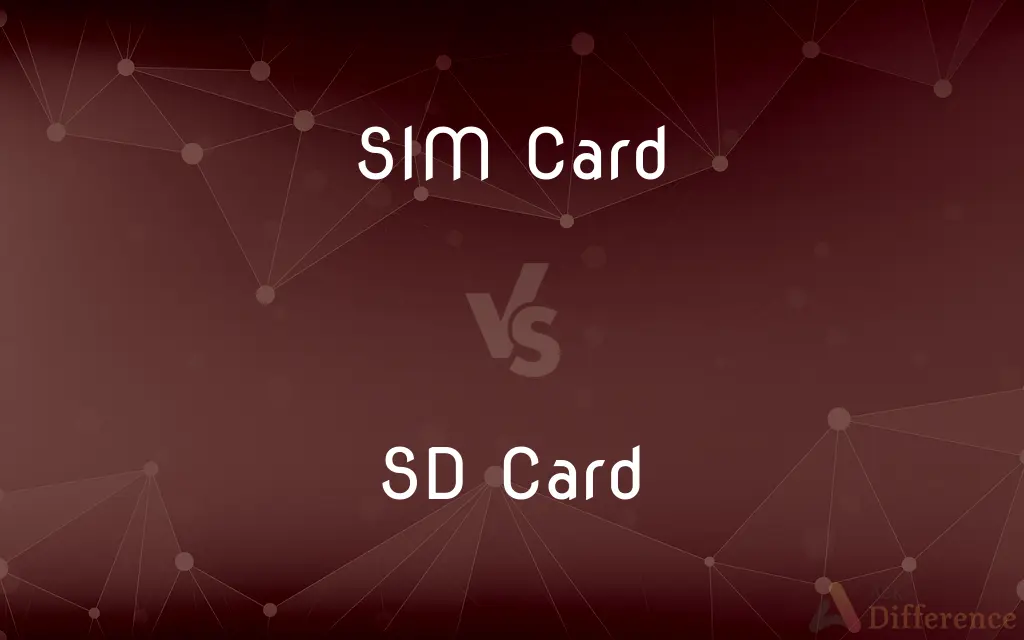SIM Card vs. SD Card — What's the Difference?
By Fiza Rafique & Maham Liaqat — Published on February 26, 2024
SIM cards are used to store subscriber information for mobile networks, enabling connectivity and communication services, while SD cards are memory storage devices used to expand the storage capacity of digital devices for files like photos and videos.

Difference Between SIM Card and SD Card
Table of Contents
ADVERTISEMENT
Key Differences
SIM cards, or Subscriber Identity Modules, are integral to mobile devices, storing information that identifies and authenticates the user's mobile network. This allows devices to connect to cellular networks for calls, texts, and data services. They come in various sizes, including standard, micro, and nano.
SD cards, or Secure Digital cards, are used as an external storage solution for digital devices such as cameras, smartphones, and tablets. They store data such as photos, videos, music, and documents, allowing users to expand the device's storage capacity. SD cards also come in different sizes, including standard, mini, and micro, with varying storage capacities.
SIM cards are essential for mobile communication and network connectivity, while SD cards are optional and serve the purpose of data storage and transfer. A device's ability to make calls or connect to the internet relies on a SIM card, whereas its capacity to store additional data depends on an SD card.
SIM cards are provisioned by and specific to mobile network operators, containing unique subscriber information, whereas SD cards are standardized storage devices that can be used interchangeably among compatible digital devices without any provision from network operators.
The choice between using a SIM card and an SD card is not either/or; they serve distinct functions. Devices often have separate slots for each type of card, allowing users to benefit from network connectivity and expanded storage simultaneously.
ADVERTISEMENT
Comparison Chart
Primary Function
Provides mobile network connectivity
Expands digital storage capacity
Data Stored
Subscriber identity, network authentication
Photos, videos, documents, and other files
Device Compatibility
Mobile phones and other cellular devices
Cameras, smartphones, tablets, etc.
Sizes Available
Standard, micro, nano
Standard, mini, micro
User Accessibility
Typically locked to a network, limited access
Freely accessible and transferable
Compare with Definitions
SIM Card
Stores user's subscription information for connectivity.
His SIM card stored his mobile number and plan details securely.
SD Card
Available in various sizes and capacities.
For her photography project, she chose a high-capacity micro SD card.
SIM Card
A small card in mobile devices for network identification and access.
After moving, she needed a new SIM card to access local mobile services.
SD Card
Data on SD cards can be easily transferred and shared.
She shared her presentation by copying it onto an SD card.
SIM Card
Essential for cellular communication services.
Without a SIM card, her phone couldn't make calls or send texts.
SD Card
Used across a wide range of digital devices.
He transferred the SD card from his camera to his laptop to upload photos.
SIM Card
Comes in various sizes for different devices.
She replaced her standard SIM card with a nano version for her new smartphone.
SD Card
Expands the memory capacity of digital devices.
Adding an SD card to his phone allowed him to download more apps and media.
SIM Card
Specific to mobile network operators.
His SIM card was provisioned by his mobile carrier, containing all necessary network information.
SD Card
A portable storage device for digital data.
She used an SD card to store extra photos and videos on her camera.
Common Curiosities
Can a SIM Card store photos and videos like an SD Card?
While a SIM card has limited storage, it's primarily for network-related information, not for general data storage like photos or videos.
What is a SIM Card?
A SIM card is a small card used in mobile devices that stores subscriber information for network access and authentication.
How do I choose the right SD Card for my device?
Consider the device compatibility (size and format), storage needs, and performance (speed class) when choosing an SD card.
Are all SD Cards the same speed?
No, SD cards come in different speed classes, indicating their minimum performance levels, important for tasks like HD video recording.
Can I use any SIM Card in my phone?
Compatibility depends on the device's network technology (GSM, CDMA) and whether it's locked to a specific carrier.
How do I transfer data from an SD Card to another device?
Data can be transferred by inserting the SD card into a compatible slot on the device or using an adapter or card reader.
How does an SD Card work?
An SD card is a portable storage device used to store and transfer digital data like photos, videos, and files across various devices.
Is a SIM Card interchangeable between devices?
A SIM card can be moved between compatible devices, but network compatibility and provisioning by the carrier must be considered.
Can an SD Card be used for mobile network access?
No, SD cards are solely for data storage and cannot provide network connectivity like a SIM card.
What happens if I use a device without a SIM Card?
Without a SIM card, a device cannot connect to cellular networks, affecting calls, texts, and mobile data usage.
Can a SIM Card improve my device's internet speed?
A SIM card itself doesn't determine internet speed; that's influenced by the network technology and the carrier's service quality.
Are there devices that use both SIM and SD Cards?
Many smartphones and tablets have slots for both types of cards, allowing for network connectivity and expanded storage.
How secure is the data on SIM and SD Cards?
SIM cards are generally secure with encryption for subscriber information. SD card data security depends on user handling and the use of encryption or password protection for sensitive data.
Do all smartphones accept SD Cards?
Not all smartphones have SD card slots; this feature varies by model and manufacturer.
What's the maximum storage capacity of SD Cards?
As of the last update, SD cards can have capacities up to several terabytes, though the most commonly used capacities range from 16GB to 512GB.
Share Your Discovery

Previous Comparison
SunPass vs. E-Pass
Next Comparison
IMAX vs. DolbyAuthor Spotlight
Written by
Fiza RafiqueFiza Rafique is a skilled content writer at AskDifference.com, where she meticulously refines and enhances written pieces. Drawing from her vast editorial expertise, Fiza ensures clarity, accuracy, and precision in every article. Passionate about language, she continually seeks to elevate the quality of content for readers worldwide.
Co-written by
Maham Liaqat















































